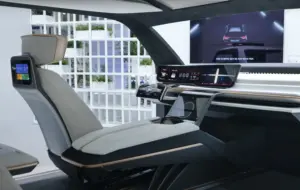The K-Display 2023 expo, held in Seoul, Korea recently, was a testament to the importance of the display industry to the Korean economy. It is also a testament to the investments being made by Samsung, LG, and the government in ensuring the OLED supply chain stays dominantly Korean. However, Chinese companies like BOE, TCL CSOT, and Visionox are also using government subsidies to build large OLED panel factories, aiming to challenge the market dominance of Samsung and LG.

Things have gotten to the point that Samsung and LG have been brought together, one becoming the supplier to the other, Samsung using LG’s WOLED panels in its TV business. The decision to work together in panel procurement could improve utilization rates for factories and help secure profits. This situation mirrors the rise of South Korean and Taiwanese companies in the display industry during the 2000s, which led to the downsizing or withdrawal of Japanese companies. It’s not like the Chinese companies are not attempting a similar approach to challenge the Korean giants. So, this year’s K-Display was also a good place to see how Samsung and LG maybe dividing up the market to maximize opportunities for each other.
Samsung Goes Big
To summarize Samsung’s position at K-Display, you could say it goes flexible displays, gaming OLEDs, and a giant MicroLED TV. That is not to discount the fact that Samsung was showing its impressive array of automotive displays or that the company lacked transparent displays or digital signage products. However, it might be a good indication of where Samsung plays to its strengths: in mobile, IT products, and premium consumer electronics. These are certainly areas where Samsung has the push and pull of its brands to hold off any challenges to its market position from the Chinese.
The recent launches of the Galaxy Fold5 and Flip5 flexibles have confirmed that the company has some rights to claim an advantage for its flexible OLED technology. While sales of flexible smartphones have some way to go before they catch up to their rigid cousins, it’s a premium market that is growing. It has traction, and it provides a more compelling upgrade or refresh than a lot of the usual model upgrades you see from mobile companies, most of them having been, at least recently, about upping screen sizes, and not much else.
LG Has Transparency and Automotive Locked
At K-Display 2023, KiHwan Son, vice president of auto marketing product planning division at LG Display, said the company aims to secure a significant share of the global vehicle display market by 2026; over 60% of the OLED market and over 40% of the low-temperature polycrystalline silicon (LTPS) liquid crystal display (LCD) market, to be precise. LG’s share of the overall vehicle display market (excluding low-end amorphous silicon LCDs) is expected to surpass 50% by 2026.
The company plans to mass-produce OLED displays larger than 30 inches for vehicles for the first time later this year. It has also prepared the infrastructure and technology for even larger pillar-to-pillar displays of 50 to 57 inches. So, it is no small wonder that the company’s booth pivots around its automotive displays. LG’s dominance in this space is going to be hard to challenge, at least not with existing vendors, and the company is going to have a backlog of orders that stretch for years by the end of 2023.
In addition, LG has superior transparent displays. I am a personal fan of transparent displays because they have the potential to permeate so many surfaces and provide added value. It’s clear for LG, too, because the retail signage market opportunity may have been niche a few years ago, but with transparent displays, it becomes a very big growth opportunity.
LG and Samsung: Cut From the Same Cloth
In reality, you can’t really say that Samsung and LG don’t have competitive products to each other in every category. It’s given in the display business that if you’re in it to win then you better be able to deliver on every and any type of display. Resources and capacity are not the problem here.
However, the subtle emphasis on one line over another, the nuances of presentation, suggests that LG and Samsung have settled on their strengths, the markets they are most dominant in, and are giving each other room to grow there. The common threat for both companies is Chinese OLED manufacturing, which has taken giant strides forward in a short space of time, stirred into action by sanctions and supply chain upheavals. Would the Chinese vendors have been as aggressive in investment in OLED if the country had not become the focus of geopolitical concerns about supply chains? Who knows.

